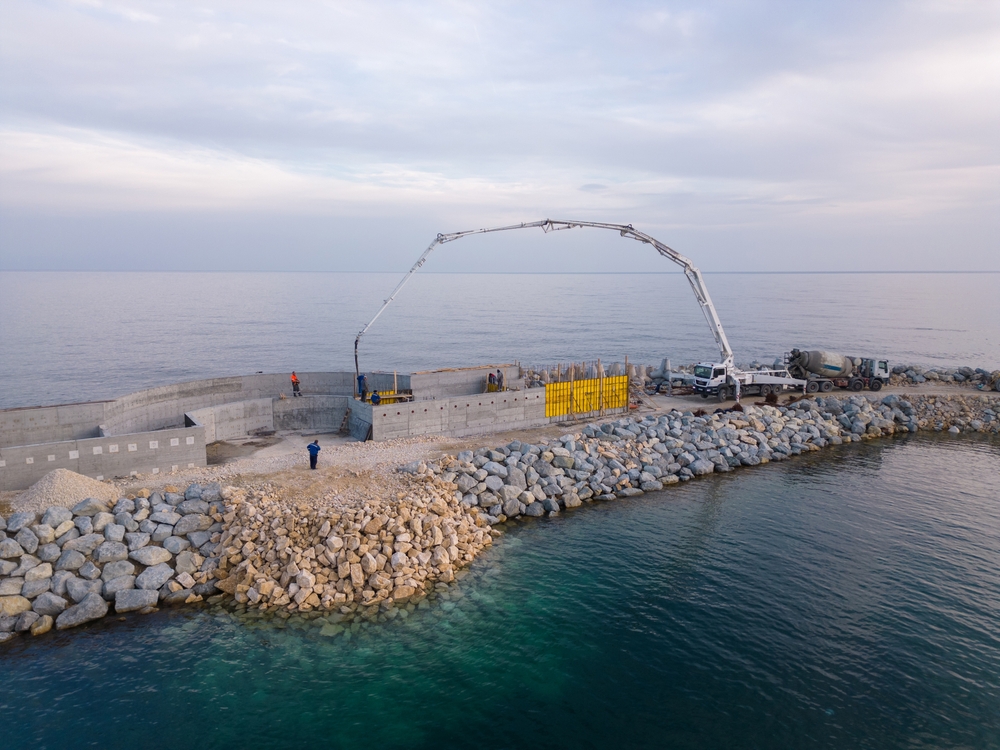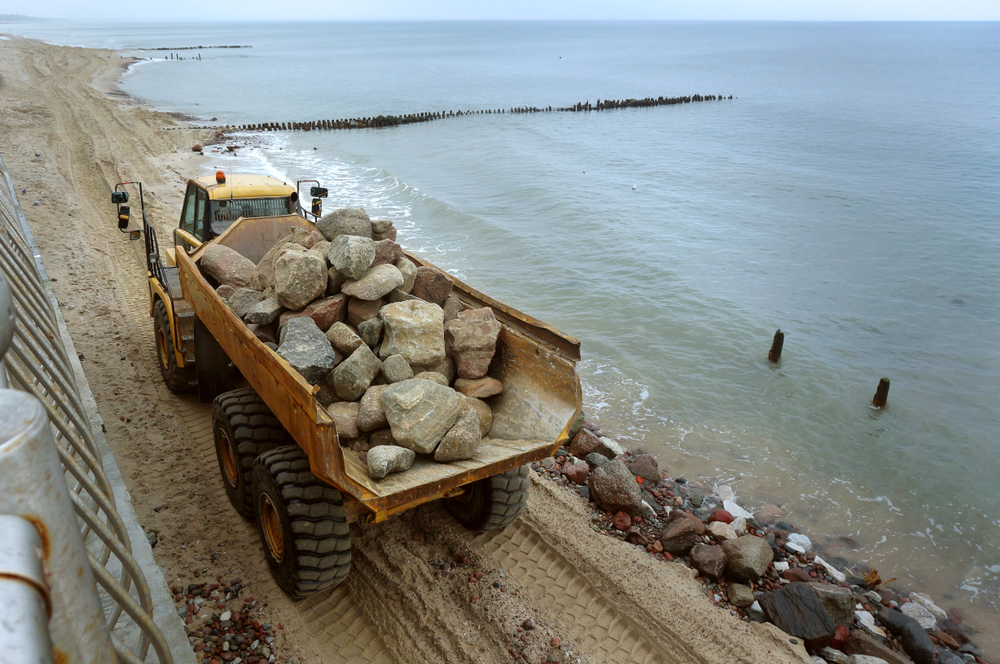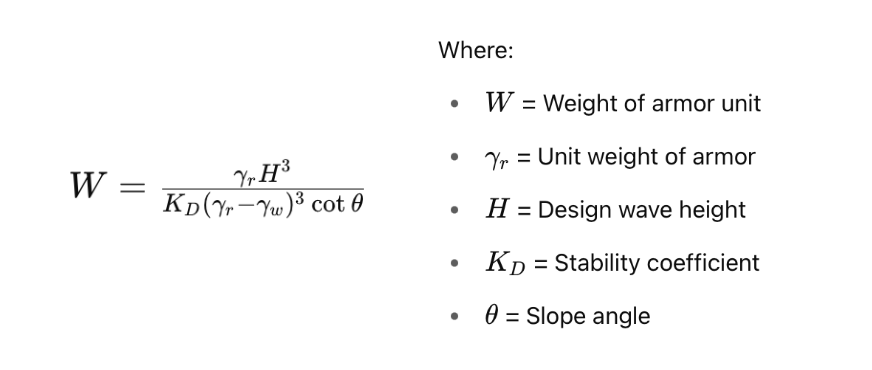Table of Contents
Breakwaters are unsung heroes of coastal engineering. These massive structures stand as the first line of defense against nature’s fiercest forces—ocean waves. But how do breakwaters work, and what makes them so effective at wave reduction and coastal erosion control? This comprehensive guide will walk you through the breakwater working principle, showcasing their role in shoreline stabilization and long-term marine engineering strategies.
What Is a Breakwater?
A breakwater is a coastal defense structure built near shorelines or around harbors to manage the impact of incoming wave energy. These structures serve a critical role in marine infrastructure by absorbing, deflecting, and reducing the force of ocean waves before they reach sensitive areas.
The primary function of a breakwater is to minimize wave action within harbor basins, ensuring safe and calm waters for docking and marine operations. Additionally, breakwaters play a vital role in preventing coastal erosion by acting as a barrier that reduces the wave energy reaching the shoreline. By doing so, they help maintain the integrity of beaches and nearby infrastructure.
Another important benefit is the promotion of shoreline stabilization. When wave energy is reduced, water motion becomes calmer behind the breakwater, allowing sediments like sand and silt to settle and accumulate. This not only protects the coastline but can also contribute to the natural rebuilding of beaches over time. These outcomes depend heavily on proper breakwater design, which ensures that the structure effectively handles the site’s specific wave and sediment conditions.
There are two main types of breakwaters:
- Fixed (Rubble Mound or Caisson): Built using rock or concrete blocks
- Floating: Made from steel pontoons or geotextile containers
How Do Breakwaters Work: The Physics Explained
At the core of the breakwater working principle is the concept of wave dissipation. Waves carry kinetic and potential energy toward the shore. If left unchecked, this energy can cause severe coastal erosion.
Breakwaters mitigate this by:
- Reducing Wave Energy: One of the primary functions of a breakwater is to weaken the force of incoming waves before they reach the shore. By physically obstructing the path of the waves, the structure causes them to lose much of their energy through processes like breaking, turbulence, and friction. This significantly diminishes their impact on coastlines, which would otherwise suffer from accelerated erosion, damage to infrastructure, and the undermining of foundations.
- Changing Wave Patterns: Breakwaters also alter the natural behavior of wave propagation. As waves encounter the breakwater, they are diffracted around the structure and partially reflected back to the open sea. This interference pattern reduces the uniform impact of wave fronts, dispersing their energy across a wider area and creating calmer waters behind the structure. This change in wave dynamics is essential for protecting harbors, moored vessels, and beach environments.
- Encouraging Sediment Deposition: In the sheltered zone behind the breakwater, the water movement becomes significantly calmer due to the reduction in wave energy. This tranquil environment encourages sediment—such as sand, silt, and organic matter—to settle out of the water column and accumulate. Over time, this process helps build up natural barriers like sandbars and beaches, which further reinforce shoreline stability and offer additional protection against future erosion.
Wave-Breakwater Interaction
When a wave hits a breakwater, its energy is divided into different forms. A portion of the wave energy is reflected back toward the open sea, bouncing off the structure’s surface. Another part is dissipated as the wave crashes and breaks, creating turbulence and friction within and around the structure. The remaining energy is absorbed or redirected, often downward or along the structure, depending on its design and materials.
By fragmenting the wave’s energy in these ways, breakwaters significantly reduce the overall force that reaches the coastline. This energy loss is what makes breakwaters a crucial tool in coastal erosion control, helping to protect the shore from the constant battering of waves.

Construction of a reinforced concrete breakwater on a rubblemound foundation, designed to protect the coastline from wave action and erosion. Heavy-duty equipment and precision engineering ensure the stability and longevity of this critical coastal infrastructure.
Types of Breakwaters and Their Mechanisms
1. Rubble Mound Breakwaters
Rubble mound breakwaters are constructed using a multi-layered system primarily composed of large, durable rocks. At the center of the structure lies the inner core, typically made up of smaller stones or quarry run, which provides bulk and basic structural stability. This core is then encased by successive layers of increasingly larger rocks. The outermost layer, known as the armor layer, is composed of the heaviest and most robust stones. These stones are deliberately arranged to form an interlocking matrix that can withstand and diffuse the powerful impact of ocean waves.
The unique design of rubble mound breakwaters allows them to dissipate wave energy effectively through both their mass and their porous composition. As waves strike the structure, water flows through the gaps between the stones, generating significant turbulence. This process causes wave energy to be lost as heat and kinetic movement within the voids, reducing the force of the wave by the time it reaches the inner shoreline. The friction between water and rock surfaces further weakens the wave energy, making this design highly efficient for coastal protection in high-energy environments.
2. Caisson Breakwaters
Caisson breakwaters are massive concrete structures, often constructed as large rectangular boxes. These caissons are usually filled with dense materials such as sand, gravel, or stone to provide weight and stability. Because of their size and weight, they are particularly suited for deep-water applications where floating or rubble mound breakwaters may be impractical.
The primary working mechanism of a caisson breakwater is based on wave reflection. The solid vertical face of the caisson reflects a large portion of incoming wave energy, significantly reducing wave intensity on the leeward side. This makes caisson breakwaters ideal for use in harbors and along urban coastlines where space is constrained and effective wave attenuation is critical. Additionally, their flat surfaces can serve dual functions, including acting as dock fronts or supporting marine infrastructure.
3. Floating Breakwaters
Floating breakwaters are modular systems typically constructed using pontoons, geotextile containers, or other buoyant materials. These components are engineered to float on the water surface while being securely anchored to the seabed using chains, cables, or vertical piles. Their lightweight and flexible configuration make them particularly suitable for areas where traditional fixed breakwaters are not feasible due to deep water, environmental concerns, or budget constraints.
The working mechanism of floating breakwaters revolves around partial wave absorption. As waves encounter the floating structure, a portion of their energy is absorbed by the buoyant modules through vertical motion and structural resistance. The rest of the wave passes beneath or around the breakwater with significantly reduced height and energy. This reduction creates a calm zone behind the structure, making floating breakwaters ideal for low-energy environments such as marinas, small boat harbors, and recreational waterfronts. Although they offer less protection than fixed breakwaters, their ease of installation and adaptability make them a valuable tool in modern coastal engineering.
Breakwaters and Coastal Erosion Control
A key reason for breakwater construction is coastal erosion control. Shorelines without protection experience continuous erosion from wave action, which can threaten infrastructure and ecosystems.
How Do Breakwaters Prevent Coastal Erosion?
Wave Reduction: One of the primary ways breakwaters prevent coastal erosion is by reducing the energy of waves before they reach the shore. By serving as a barrier, breakwaters disrupt the momentum of waves, dispersing their energy outward or forcing it to dissipate. This results in significantly lower wave energy at the shoreline, which helps protect it from erosion caused by constant wave action.
Sediment Trapping: The calmer waters that exist behind breakwaters allow for suspended sediments—such as sand, silt, and organic material—to settle. In natural conditions, wave energy keeps these particles in motion, but when that energy is diminished, the particles drop out of the water column and accumulate. This accumulation of sediment can build up beaches or sandbars, further reinforcing coastal stability.
Shoreline Retention: Breakwaters play a crucial role in preserving artificial and natural beaches by preventing the erosion of deposited sediments. In areas where coastlines are engineered or enhanced for tourism, recreation, or property protection, maintaining the position and shape of the shoreline is vital. Breakwaters contribute to this by creating a protected environment where sediments are less likely to be washed away, ensuring that beaches and other coastal features are retained over the long term.
Breakwater Design: Engineering Considerations
Designing an effective breakwater involves analyzing multiple site-specific factors:
Key Parameters
Wave climate refers to the statistical distribution of wave heights, periods, and directions at a given site. Understanding these parameters helps engineers estimate the maximum expected forces on a breakwater and choose a suitable design that can withstand both typical and extreme conditions.
Water depth is critical because it influences the size and type of breakwater that can be constructed. Deeper waters may require caisson structures or specially adapted floating systems, while shallower areas are more suited for rubble mound breakwaters.
Seabed material determines the foundation’s stability. If the seabed is soft or composed of loose sediments, additional groundwork or piling may be necessary to prevent structural settlement or failure. Rocky or firm seabeds provide a more secure base for heavy breakwater components.
Tidal range affects the water level variation throughout the day. This must be considered when designing the elevation and overall height of the breakwater to ensure effective wave blocking across all tidal conditions.
Sediment transport patterns refer to how sand and silt naturally move along the coast due to wave and current action. Engineers must account for these patterns to avoid unintended erosion or sediment buildup in undesirable locations after a breakwater is installed.

Proper breakwater design requires analyzing wave climate, water depth, and seabed material to select the right size and type of armor stone. Engineering accuracy in material selection is critical for long-term shoreline stabilization and structural resilience.
Design Formula (Hudson’s Equation):

Environmental and Ecological Impact
While breakwaters are essential for shoreline stabilization, they can alter natural sediment flow and marine ecosystems.
Breakwaters, while beneficial for shoreline protection, can also have unintended environmental consequences if not carefully designed and monitored. One significant concern is sediment starvation down-drift of the structure. When breakwaters trap sediment in one area, they may deprive neighboring shorelines of the natural sand flow, leading to increased erosion elsewhere. This redistribution of sediment can upset the delicate balance of coastal sediment transport systems.
Another issue is habitat disruption. Breakwaters, especially those with a solid and impenetrable structure, can disturb marine habitats by altering water flow, blocking species migration paths, or reducing the availability of sunlight and nutrients in certain areas. Species that rely on natural seabed environments may struggle to survive or reproduce near these artificial barriers.
Additionally, algal blooms can occur in stagnant water areas behind breakwaters where circulation is reduced. These blooms can lead to oxygen depletion in the water, harming fish and other marine organisms, and sometimes result in the release of toxins harmful to both aquatic life and humans.
To mitigate these environmental risks, sustainable alternatives have been developed. One approach involves the use of eco-concrete breakwaters, which are designed with rough surfaces and crevices that promote marine biodiversity by mimicking natural habitats. These structures not only protect coastlines but also serve as artificial reefs.
Another innovative solution is the creation of submerged reef-style breakwaters. These structures sit below the water surface and encourage the growth of coral, seagrass, and other marine life while still providing wave attenuation. By integrating ecological considerations into breakwater design, engineers can enhance both shoreline resilience and environmental health.
How Breakwaters Protect the Shore in Different Conditions
| Condition | Type of Breakwater | Why It Works |
|---|---|---|
| High wave energy | Rubble Mound | High dissipation via rock voids |
| Deep water harbors | Caisson | Strong reflection and stability |
| Urban shorelines | Caisson or Eco-Caisson | Durable and multi-functional |
| Marinas and lakes | Floating | Quick install and minimal footprint |
Breakwater Maintenance and Monitoring
Breakwaters require regular inspection and upkeep to remain effective.
Regular maintenance is essential to ensure that breakwaters continue functioning effectively over time. One important task is settlement monitoring, which involves checking whether any part of the structure has shifted or sunk due to underlying soil movement or wave pressure. Any such settlement can compromise the integrity of the breakwater and should be addressed promptly.
Armor stone repositioning is another key activity, especially for rubble mound breakwaters. Over time, high-energy wave action may displace some of the protective stones, reducing the breakwater’s ability to dissipate wave energy. Replacing or realigning these stones helps restore the original design performance.
For steel or floating breakwaters, corrosion checks are vital. Saltwater exposure can lead to the gradual deterioration of metal components, threatening structural stability. Regular inspection and anti-corrosion treatments are necessary to extend the life of these structures.
To support these efforts, advanced technologies are increasingly being used. Drones allow for efficient aerial surveys, making it easy to assess the condition of breakwaters from above without requiring physical access to every part. Underwater remotely operated vehicles (ROVs) provide a safe and detailed view of submerged sections, detecting hidden structural damage or biofouling. Additionally, wave sensors installed on or near the breakwater can deliver real-time data on wave impact and stress, enabling proactive maintenance planning and improved structural resilience.
By strategically interrupting wave energy, encouraging sedimentation, and providing coastal erosion control, these structures ensure long-term shoreline stabilization. As marine engineering evolves, innovations like eco-friendly materials and AI-based monitoring will make breakwaters even more effective.
Whether you’re a contractor, civil engineer, or coastal planner, understanding the working mechanism of a breakwateris key to designing resilient shorelines for generations to come.




